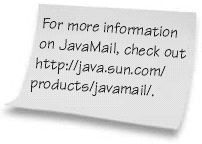The Server Side
| The application server for the Web-based email client will be responsible for connecting to the mail server and retrieving emails via Post Office Protocol (POP). Along the same lines, the application server must be able to send email to the mail server via Simple Message Transfer Protocol (SMTP). This will provide for a two-way communication process between the mail and application servers. The implementation of this functionality will be invisible to the user, and the interface must be fast and reliable. Three leading application servers were researched to determine which would be the best fit for the application. Simpleton wants not only the best software for the job but something that will scale and let it build more complex applications in the future. Active Server Pages (ASP)ASP runs on Windows servers and allows developers to create dynamic Web applications that can be tied into enterprise databases. Microsoft's Internet Information Services (IIS) provides the Web server that parses ASP templates and serves up the content. IIS is simple to administer and provides extensive functionality and control of the sites running on it. ASP can be written in either VBScript or JScript to build Web applications. This can be an advantage to developers who have a JScript or VBScript background. For others, the learning curve will be steeper since they will be dealing with an entirely new language. ASP doesn't contain built-in support for POP; therefore, a custom component will have to be written and accessed via the ASP templates. A possible solution would be to use a third-party email component written in ASP. All this functionality comes at a cost, and a Windows server will need to be purchased to run ASP pages. Since the Simpleton server is running the Linux OS, this is not a viable option. JavaServer Pages (JSP)JSP allows developers to create dynamic Web applications that are easy to maintain using the Java language. JSP uses XML-type tags and scripts that are parsed by the Java server and displayed. Java application servers are available for both Linux and Windows operating systems. This is a major benefit, since an application can be written on any platform and run anywhere the Java server is installed. JSP extends Java servlets, which are server-side components that encapsulate the application logic and allow for the separation of code and display. When applications are built in a modular format, they are easier to maintain and update. Since JSP doesn't have the built-in capability to communicate with email servers over POP, the code will have to be developed for the email application. There is also a JavaMail application programming interface (API) that can be downloaded and can communicate via POP. If JSP is chosen for the email application, the most time- and cost-effective solution will be to download and install the JavaMail API.
JSP is an affordable solution, and in some cases, as with Apache Tomcat, it's free. Since JSP can run on a Linux server, this is a candidate for the application. Macromedia ColdFusionColdFusion is Macromedia's application server, which runs on both Windows and Linux. ColdFusion Markup Language (CFML) is a tag-based language that allows for RAD . Similar to HTML, CFML is easy to read and allows developers to pick up the syntax quickly. Any developer coming from an HML background should have minimal problems learning how to develop ColdFusion applications. With ColdFusion MX, the application server can be leveraged to build future applications that communicate with databases, run JavaServer Pages, Java servlets, and Enterprise Java Beans (EJB). The numerous possibilities of this application server go beyond the realm of building a Web-based email client. Simpleton intends to develop more complex applications in the near future, and ColdFusion will allow it to do so. Another advantage of ColdFusion is that it has built-in functionality to communicate with different mail servers over POP. The CFPOP tag just needs to be called and passed a few attributes, and the rest is history. Email can be easily retrieved, read, and deleted directly from the server. Receiving mail is only one side of the coin users also need to be able to send mail. ColdFusion can send mail to be handled by any mail server via SMTP. Along with the already mentioned functionality, ColdFusion has an incredible administrative console. This is something the previously mentioned application servers can't boast about. The admin console is written in CFML and can be accessed through most Web browsers. Settings such as security, data source names, variables, and debugging can all be controlled by a mere click of a button. A license for the ColdFusion server is extremely affordable, compared with the money that will be saved during development, maintenance, and debugging. ColdFusion meets and exceeds all specifications described in the Product Requirements phase. Based on this information, ColdFusion also seems to be a viable server solution for the application. |
EAN: 2147483647
Pages: 114
- Chapter V Consumer Complaint Behavior in the Online Environment
- Chapter VIII Personalization Systems and Their Deployment as Web Site Interface Design Decisions
- Chapter IX Extrinsic Plus Intrinsic Human Factors Influencing the Web Usage
- Chapter XIII Shopping Agent Web Sites: A Comparative Shopping Environment
- Chapter XV Customer Trust in Online Commerce
